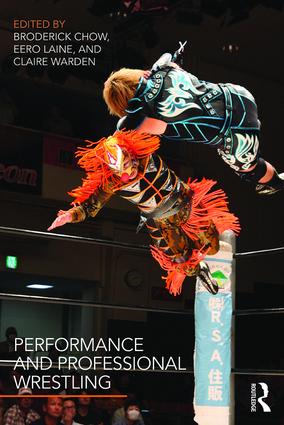 Edited by Broderick Chow, Eero Laine, and Claire Warden, Performance and Professional Wrestling is a substantial collection of essays that looks beyond confirming wrestling as a performance art medium and instead asserts the vitality of the form as a catalyst for socio-political transformation. In their introduction, Chow, Laine, and Warden first analyze the audience of the violent performance art form. Through audience analysis, the editors argue that professional wrestling challenges normative representations of gender, sexuality, and post-colonial identities in a hyperreal and hyperactive stage. The book proves this assertion through an extensive collection of case study essays written by anthropologists, sociologists, performance theorists, journalists, and choreographers from a myriad of socio-political backgrounds. The authors grapple with professional wrestling’s context within history and athleticism in order to advance scholarship and critical analysis within the form.
Edited by Broderick Chow, Eero Laine, and Claire Warden, Performance and Professional Wrestling is a substantial collection of essays that looks beyond confirming wrestling as a performance art medium and instead asserts the vitality of the form as a catalyst for socio-political transformation. In their introduction, Chow, Laine, and Warden first analyze the audience of the violent performance art form. Through audience analysis, the editors argue that professional wrestling challenges normative representations of gender, sexuality, and post-colonial identities in a hyperreal and hyperactive stage. The book proves this assertion through an extensive collection of case study essays written by anthropologists, sociologists, performance theorists, journalists, and choreographers from a myriad of socio-political backgrounds. The authors grapple with professional wrestling’s context within history and athleticism in order to advance scholarship and critical analysis within the form.
According to the essayists, "heat," "blade," and "hyperreality" are professional wrestling's active ingredients for social change in liminal fighting rings. These essays delve into the evolution of professional wrestling as a liminal space for active audience engagement and span a range of topics from audience, circulation, and Lucha to gender, queerness, bodies, and race within professional wrestling. Performance and Professional Wrestling expertly highlights terms within professional wrestling as modes to interpret social experimentation in the ring. These terms are "heat," audience reaction inside and outside of the performance, "blade," the reality of the wrestler's actions and pain, as well as "hyperreality," extremely specific details within a performance that make the performers feel like real opponents to the audience. Each essay features a highly qualified and distinctive voice that eloquently interpolates and defines these performative terms. Despite the variations in style throughout the book, at the core of these vast perspectives is the assessment of the wrestling ring as a liminal space for audience participation.
Janine Bradbury's contribution, "Gender, Sexuality, and Performance in the WWE debuts of Goldust and Marlena" is an audience-centric gem of critical analysis within this collection of essays (107). Bradbury elegantly enmeshes the performance of professional wrestling with the performativity of gender and objectification of sexuality. She boldly lauds and simultaneously chastises the professional wrestling audience through the years for their "heat" towards wrestlers that queer the form. Bradbury states, "In place of the law of heterosexual coherence, we see sex and gender denaturalized by means of a performance which avows their distinctness, and dramatizes the cultural mechanism of their fabricated unity" (109). Bradbury deliberately forces the reader into the "heat" of the social controversies within professional wrestling, consciously building up free expression within the performer and audience while condemning the exploitation of genderqueer stereotypes. She triumphantly preconizes the performer as a champion of audience intercessions for queer expression while exposing the misogyny and homophobia within commercial wrestling.
The most gripping account and assessment of social "heat," "blade," and "hyperreality," within professional wrestling is found in Charles Hughes essay, "'Tell them it's what their grandfathers got': Racial Violence in Southern Professional Wrestling" (165). Hughes delves into the historicization and performativity of the American South through the lens of professional wrestling, exposing key storylines from "intersections between racial and regional conflict" in the South (173). He dissects the evolution of black bodies in wrestling performance as well as the audience interactions with racially driven storylines. Hughes argues that although the history of professional wrestling in the South is riddled with oppression and dehumanization of black professional wrestlers and black audience members, the industry itself has transformed. In the last thirty years, the professional wrestling has worked to centralize black protagonists within the American wrestling narrative. These protagonists go on to perform in national and international rings as American heroes and audience favorites. He diligently affirms that the American professional wrestling ring is a space of liminality through which audiences and performers can work through historical conflict and enact social change.
Overall, Performance and Professional Wrestling is a thorough investigation of social liminality within the professional wrestling performance. Each essay offers a unique perspective on the importance of professional wrestling as a form of performance art for social change. This book captures the bold as brass performance style of professional wrestling in its collection. The voices ebb and flow together allowing the reader to enter into multiple social contexts for wrestling performance. Each author leaves their imprint on the practical application and theoretical study of professional wrestling. This style allows the reader to dive into the form analytically as well as narratively. Broderick Chow, Eero Laine, and Claire Warden have compiled an anthology of excellence in socio-political theory and criticism of the form. Performance and Professional Wrestling is a treasure of essays from a diverse collection of expert sources that dives into the craft of creating social revolution through wrestling performance.
— Reviewed by Leah Johnson, Texas Tech University
Leah Johnson is an M.F.A. candidate in Performance & Pedagogy at Texas Tech University. Her work focuses on liminal spaces for intersectional feminism and includes directing, acting, vocal coaching, intimacy choreography, and devised collaboration. Recent Credits Include: Vocal Coach for Grounded at Outpost Repertory Theatre and Vocal Coach for Black Girl, Interrupted (World Premiere) at Texas Tech University.


